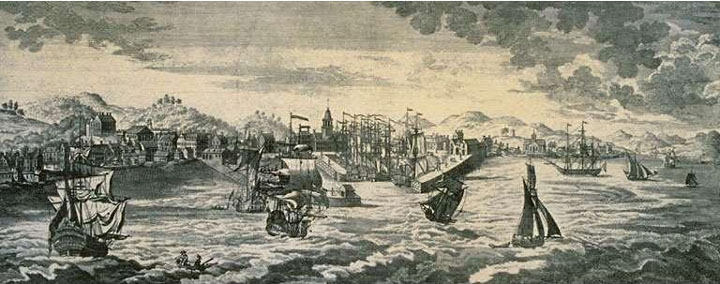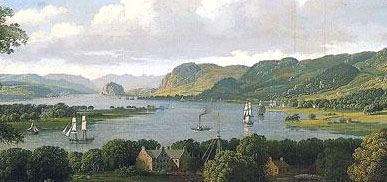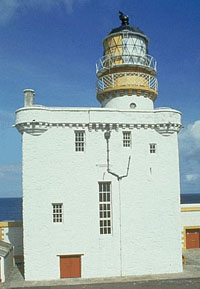The eighteenth century brought changes in patterns of trade, with an increase in traffic between the west coast and the Americas. Ships were getting larger, and needed bigger, more sheltered and deeper harbours. Commercial pressures also led to demand for more quayside space, and better cargo handling facilities. Many long established small ports, particularly on the east coast, failed to develop. Some were squeezed out by more ambitious neighbours, as Bo’ness was by Grangemouth. Like industrial towns, some ports specialised. Newburgh in Fife, for example, shipped mixed cargoes of salmon and stone to London, while Dumfries exported livestock. Many ports in the south west traded with Ireland. Some, such as Kincardine-on-Forth and Kirkcudbright, specialised in shipbuilding.

Illustration of Greenock, 1786.
© SCRAN/Mitchell
Library, Glasgow City Libraries and Archives
New or fast-growing ports during the eighteenth
century included Port Glasgow, founded in the 1660s, but massively developed
in the eighteenth century, and its great rival Greenock, both providing
better facilities and deeper water than the riverside of Glasgow itself,
in fact the deepest harbours north of Liverpool. By the 1820s some ports
were providing wet docks, dry docks, graving docks, quayside cranes and
weighing facilities, as well as improved storage facilities. This was
easier to achieve on new spacious sites rather than in older ports with
buildings crowded around the shore.
Detail of painting by John Knox showing
the first steamship on the Clyde, c.1820.
© SCRAN/Glasgow Museums
As passenger transport improved, ferry ports
developed, such as Kinghorn in Fife, or Portpatrick in Wigtonshire, situated
at the end of a military road from Carlisle and developed by the government
to improve communications with Ireland. The advent of steam ferries from
the 1820s allowed timetables to be adhered to, greatly improving overall
travel times and costs. Some ports, however, were short-lived as transport
networks changed. Coastal shipping remained important, but some of its
routes were changed by the opening of the Forth and Clyde Canal in 1790.
All harbours involved major capital outlay, for their initial construction and for frequent repairs and upgrading. Their management was often devolved from town councils to dedicated harbour trusts. Some of these were ambitious and imaginative, some were over-ambitious, while others were too cautious, and were left behind in the race to attract the ships and cargoes whose anchorage and shore dues provided the income for harbour maintenance. Initial capital was often provided by landowners, or by the producers or purchasers of cargoes, and by government grants, but only good management could ensure a steadily rising income and justify further capital expenditure. Many harbours fell by the wayside, including some very expensive projects which were just in the wrong place at the wrong time, such as Wick.
Kinnaird Head lighthouse,
Fraserburgh, built in 1787 on top of a tower house. |
Much of the coastline of Scotland was surveyed or re-surveyed during the
eighteenth century, and charts published. The Commissioners for Northern
Lights, established in 1786, had by 1794 built or replaced seven lighthouses,
Kinnaird Head, Mull of Kintyre, North Ronaldsay (Orkney) and Eilan Glas
(southern tip of Lewis), Pladda (at the southern tip of Arran), Cumbrae
and the Pentland skerries. These were simple and functional buildings,
the forerunners of the massive but elegant lighthouse towers of the nineteenth
century.
The same period also saw the building of locally-financed harbour lights, such as the signal tower at Aberdeen.

